
















The Florida Chapter of the American Planning Association has establishedaCommunityPlanningAssistanceTeam(CPAT)program dedicatedtoofferingstatewideassistancetocommunitiesinneedof small and large scale projects through multidisciplinary teams of planning professionals. In July 2021, Sharon Austin of Hand-n-Hand CommunityServicesFoundation,Inc.,contactedAPAFloridatoaskfor assistance in identifying revitalization strategies to spark economic development and small business opportunities for East Palatka residents while also preserving the community’s history, cultural heritage, and sense of place. In early 2022, APA Florida’s Community Planning Assistance Team (CPAT) committee selected the communityofEastPalatkatoserveasthefocusoftheChapter’spilot CPATproject.
EastPalatkaisahistoricagriculturalcommunitywithGullahGeechee heritage, located along the St. Johns River in eastern Putnam County between Palatka and Hastings. East Palatka was established during the 1880s as an important railroad junction along Henry Flagler’s Florida East Coast Railway. Following the railroad’s abandonment, construction of State Road 207, and Interstate 95, East Palatka declinedeconomically.NowbisectedbytheSt.Augustine-to-Palatka Trail (the former FEC railroad corridor), the community is characterized by brick streets, small-frame residential dwellings, historicchurches,amaturenaturallandscape,andagriculturalfields. Members of the volunteer pilot CPAT began engaging with the communityin2022withvisitsinJulyandNovember,andagaininApril 2023.
Prioritiesasidentifiedwiththecommunityinclude:
HistoricPreservationandCulturalHeritage
ParksandRecreation
HousingandBusiness
Jobs,TrainingandEducation
Advocacy
This report summarizes the activities of the East Palatka CPAT along with recommendations related to community priorities. These recommendationsaresharedintermsofshort-term(1-2years),midterm (3-5 years), and long-term (5+ years) goals. The recommendations are further grouped by what the community can doandwhatneedspartnerships.



The East Palatka CPAT extends heartfelt thanks to Sharon Austin for her leadership, and the community for their hospitality and enthusiasm. It is the hope that the CPAT members can continue to serveasaresourcefortheEastPalatkacommunity.
EastPalatkaisahistoricagriculturalcommunitywithGullahGeechee heritage, located along the St. Johns River in eastern Putnam County between Palatka and Hastings. The Gullah Geechee people are the descendantsofCentralandWestAfricanswhohavetraditionallylived along the coasts of southeastern North Carolina, South Carolina, GeorgiaandNortheastFlorida.
The African presence along the St. Johns River dates as far back as the 16th century, well before the 1607 founding of the British colonies, andincludedpeoplefrommanydifferentAfricansocieties.Themixing of these diverse African peoples over time created the unique, creole Gullah Geechee culture, which has retained many African cultural expressions that can be experienced in East Palatka’s religious institutions,artsandcrafts,architecture,musicandfood.
East Palatka was established during the 1880s as an important railroad junction along Henry Flagler’s Florida East Coast Railway. The communitydevelopedthroughthe20thcenturyasaruralagricultural settlementthathastraditionallybeenhometopotato,cabbagefarm laborersandamigrantlaborpopulation.PriortoWorldWarII,alinear commercial corridor developed along the railroad tracks in the vicinity of a passenger depot and West McCormick Road and Louis BroerRoad.
Followingtherailroad’sabandonment,constructionofStateRoad207, andInterstate95,EastPalatkadeclinedeconomically.Nowbisected
by the St. Augustine-to-Palatka Trail (the former FEC railroad corridor), the community is characterized by brick streets, smallframe residential dwellings, historic churches, a mature natural landscape,andagriculturalfields.
In July 2021, Sharon Austin of Hand-n-Hand Community Services Foundation, Inc., contacted APA Florida to ask for assistance in identifying revitalization strategies to spark economic development andsmallbusinessopportunitiesforEastPalatkaresidentswhilealso preserving the community’s history, cultural heritage, and sense of place. In early 2022, APA Florida’s Community Planning Assistance Team (CPAT) committee selected the community of East Palatka to serveasthefocusoftheChapter’spilotCPATproject.
The Florida Chapter of the American Planning Association has establishedaCommunityPlanningAssistanceTeam(CPAT)program dedicatedtoofferingstatewideassistancetocommunitiesinneedof small and large scale projects through multidisciplinary teams of planning professionals. CPAT volunteers offer a diverse set of skills and expertise working with local stakeholders, community leaders, elected officials, and volunteers to address a challenge, envision a plan, and create an implementation strategy. Projects may include consensus building, economic development, housing, urban design, transportation, energy, recreation, etc. Team members are selected according to expertise required for each unique project to offer probonoassistance.
CPAT projects allow financially constrained communities to receive pro-bono assistance from professional planners with various backgrounds and expertise in order to address a diverse range of issuesfacingcommunities.
TheAmericanInstituteofCertifiedPlanners(AICP)CodeofEthicsand ProfessionalCodecallsplannerstoupholdanethicalcommitmentto enrich and expand the abilities of communities to sufficiently meet the needs of its people through addressing “policies, institutions, and decisions that may oppose such needs.” The APA Florida Chapter CPATprogramisdedicatedtoensuringourcommunitiesaremetwith justandequitableplanningsolutions.
EastPalatkaCPATpilotteammembersandcontactinformation:
EnnisDavis,AICP(CPA
AdrienneBurke,AICP,
DevanLeavins
JosephineMedina,AI
RaySpofford,AICP
KyliePope
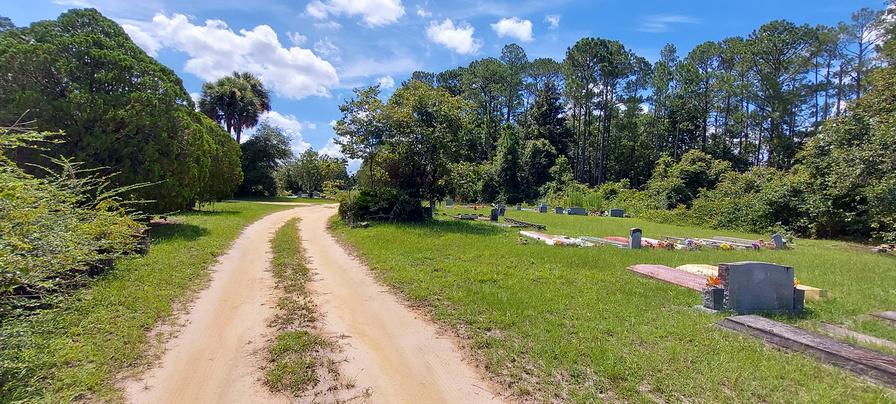
July9,2022
In preparation of the East Palatka pilot project, Ennis Davis, AICP, APA Florida’s vice president of Membership and Outreach Services, met withSharonAustinonJuly9,2022inEastPalatka.Thepurposeofthis initial outreach visit was to tour the community and engage with communitystakeholders,inordertobuildaCPATpilotteamfeaturing skills and expertise in special niches of the planning field directly impacting the community’s short- and long-term goals. As a result, AdrienneBurke,AICP,Esq.;EnnisDavis,AICP;DevanLeavins;Josephine Medina, AICP; Kylie Pope; and Ray Spofford, AICP, were selected and volunteered to serve as members for the APA Florida East Palatka CPAT.
November4-5,2022
On November 4 -5, the APA Florida CPAT pilot team explored East Palatka to learn more about the community. Hosted by resident Sharon Austin, the CPAT team toured the community and met with several residents to understand more about East Palatka’s history, culture,challenges,desires,andpotentialrevitalizationopportunities.
Inacommunitywherefoodisanintegralpartofthelocalcultureand economics, fish fry and barbeque were communal meals historically linked to East Palatka. As a part of the community engagement process,longtimeresidentsTerryMajorandSheilaCrawfordprepared theselocaldishesfortheCPATmembersandguestsinattendance.
On November 5, 2022, residents gathered for a community meeting and CPAT working session at the Mount Olive African Methodist EpiscopalChurchAnnexat115PineStreet.APAFloridaImmediatePast President Wiatt Bowers, AICP, also attended the working session. Based on community feedback, major neighborhood priorities focusedontheneedforacommunitycenter,parkamenitiesforlocal children,historicpreservation,affordableandmixed-incomehousing, andeducationaltrainingforresidents.
As a result of the community meeting and working session, the APA Florida CPAT observed a need for the Chapter to assist the East Palatka community with capacity building and collaboration with allied organizations, as opposed to the traditional APA National CPAT model of visiting a community once and producing a report as the finalCPATprojectdeliverable.
After the November 2022 event, the APA Florida CPAT reached out to the University of Florida’s Historic Preservation program to gauge availability to assist with surveying historic resources in the East Palatkaneighborhood.ThesurveyingwouldleadtocreationofFlorida Master Site File forms to be submitted to the Florida Division of Historical Resources. This is the first step in preparing nominations to the National Register of Historic Places, which is a tool that could recognize the heritage of East Palatka and also lead to potential fundingopportunities.
Dr. Cleary Larkin, director of the UF Historic Preservation program, alongwithProfessorLindaStevensonexpressedinterestandtheCPAT
made plans to host a community event in Spring 2023 to share with thecommunityhowtocompletetheFloridaMasterSiteFileforms.Dr. Larkin also involved Dr. Kathryn Frank with the Urban and Regional Planning program at UF. Dr. Frank’s Community Engagement class assisted in preparing for this community engagement event, which was held on April 8, 2023. Plans were to share information on the site file forms, collect resident’s histories, and inquire about usage and potentialimprovementstotheEastPalatkaCommunityPark.
Dr.Larkin,ProfessorStevenson,Dr.FrankandseveralstudentsfromDr. Frank’s class attended the event, along with CPAT members Ennis Davis and Adrienne Burke. The event was coordinated with Sharon AustinandDeaconRalphDallasofMorningStarBaptistChurch,where the event was held. Community members attended and were interested in an open sharing of their community memories, which wererecordedtobesharedwiththecommunityfortheirkeepingand use. There was also discussion about preservation of Central Academy in Palatka, and possible future steps for the community generally.Dr.LarkinprovidedanoverviewoftheFloridaMasterSiteFile andhowitisused.
While there, Dr. Larkin and Professor Stevens selected a handful of sitestorecordincludingtheMorningStarBaptistChurch,EastPalatka Elementary, and Mt. Nebo Baptist Church. They also left information for residents on how to complete the forms and provide information to assist in completing forms. Next steps include a continued partnership to record more historic sites as well as plan for another communityengagementeventinFall2023thatwillworkonparksand recreation plans for the former community center site on W. McCormick Road, the portion of the Palatka to St. Augustine trail that runsthroughEastPalatka,andtheEastPalatkaCommunityPark.
ItemsinBOLDarethose recommendsasprioriti timeframeideas;some moveduporsomethin Partnersidentifiedares notlimitedtoonlythose Short-Term(1to2year
WhattheCommunityC
HistoricPreservation
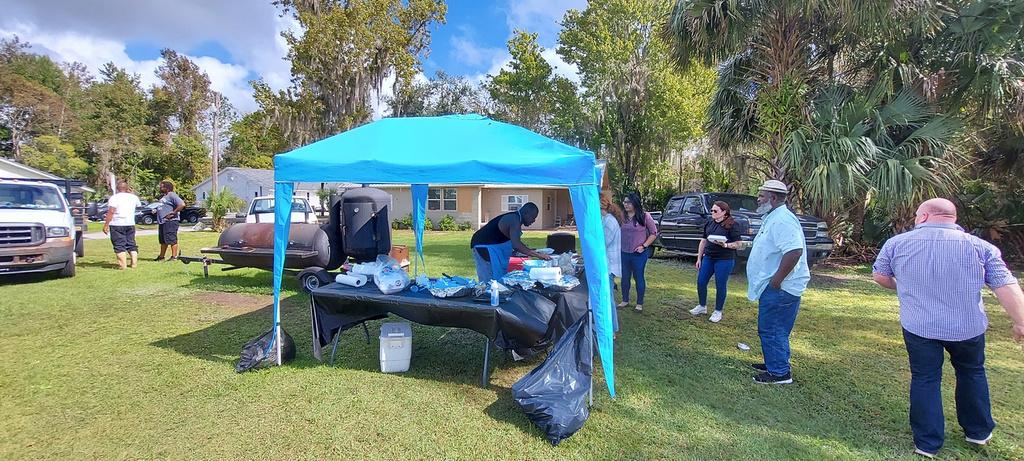
Document oral histories of residents within the community. This could be done by residents in writing or with voice recordings;theimportantthingistoidentifywhocanpreserve the documents and recordings within and outside the community.
Submit an application for the Florida Trust for Historic Preservation 11 to Save program. The entire community can be nominatedforthisdesignationanditprovideseligibilityforthe 11toSavegrantprogram.
Coordinate with the Florida Division of Historical Resources regarding a potential National Register of Historic Places nomination.
Identify specific historic projects in the community that could bepotentialgrant-fundedprojects.
Create a temporary historic heritage trail that uses temporary signagetomarkimportantsitestothecommunity.
Advocacy for the community applies to all categories and activities mentioned in this report’s recommendations. Maintaining relationships with and informing County staff and elected officials about goals and activities of the community is important, especially inseekingfundingfromtheCountyandstate.
Re-establish the community group that used to meet at the CommunityCenter.
Whenthegroupisorganizedandfunctioning:
Meet with County Commissioner and attend Commission meetings.
Learn about the County’s budgeting process to identify ways projectsinEastPalatkacanreceivefutureCountyfunding.
Meet with County Planning & Development Services DepartmentandCountyParks&Recreation.
MeetwithFloridastaterepresentative.
Coordinate with similar communities exploring similar efforts, learningfromanetwork.TheAPAFloridaCPATcanassistinmaking connections.
Completion of Florida Master Site File forms documenting buildingsandspacesinthecommunity. Thesearesubmitted totheFloridaDivisionofHistoricalResources.Partner:University ofFlorida
Create a history brochure highlighting the community’s heritage that could be placed at the Palatka to St. Augustine trailheadsign.Partner:APAFloridaCPAT
Hold a Cemetery Resource Protection Training event at Pattersonville Memorial Cemetery. Partner: Florida Public ArchaeologyNetwork
Identify a place to store oral histories so they are preserved. This could be someone or an organization in the community. Partner:PutnamCountyLibrarySystem
Identify projects important to the community that may be eligible for grant-funding and work with partners to apply for grants.Partners:APAFloridaCPAT,UniversityofFlorida,Putnam County
ParksandRecreation
Havecommunityconversationaroundrecreationopportunities connectingfromW.McCormickRoadalongthetrailtotheEast Palatka Community Park. Partners: University of Florida, APA FloridaCPAT
Construct community amenity at location identified by the community (example: picnic shelter) Partner: APA Florida First CoastSection
Consider Palatka to St. Augustine trail improvements in the community, such as installation of five to six historic markers along trail, and a trailhead with shelter, benches and trees. Partners:APAFlorida,FloridaStateParks,grantfunders
Get a marked crosswalk on Putnam County Boulevard -to connect to the East Palatka Community Park. Partner: Putnam County
Address affordable housing concerns and heirs property issues.Partner:LISCJacksonville
Share information in the community about utility, rental, and mortgage payment assistance programs. Partner: Heart of Putnam
Identify opportunities for supporting small businesses in the community. Partner: Florida Small Business Development CouncilatUniversityofNorthFlorida
Share information about allowable home-based businesses. Partner: Putnam County Planning & Development Services, Florida Small Business Development Council at University of NorthFlorida
Begin discussions about zoning changes that support more affordable housing and reusing commercial properties in the neighborhood. Partners: APA Florida CPAT, Putnam County Planning&DevelopmentServices
Jobs,TrainingandEducation
Sharefinancialandeducationalassistanceprograms.
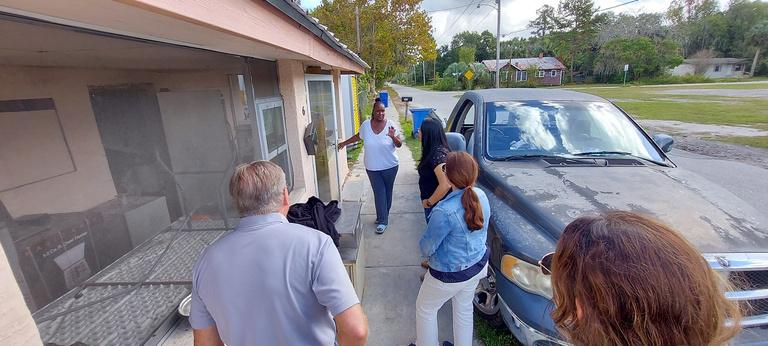
Identify needs and options for use of historic East Palatka Elementary, such as a technical training center or business incubator. Partners: Putnam County School Board, Putnam CountyEconomicDevelopmentCouncil
Begin conversations for future use of historic East Palatka Elementary:Partner:PutnamCountySchoolBoard
Seek community designation to National Register of Historic Places.Partner:FloridaDivisionofHistoricalResources
ParksandRecreation
DevelopplansforacommunitycenteronW.McCormickRoad. Partner:PutnamCountyParks&Recreation
Continue plans and implementation as identified by the community for East Palatka Community Park and activating the Palatka to St. Augustine trail. Partners: Florida State Parks, PutnamCounty,grantfunders
Add trees to the trail between E. River Road and W. McCormick Road. Partners: Florida State Parks, Putnam County, grant funders
Add shelters and benches along the trail at Louis Broer Road, CrossRoad,TillmanAvenue,andW.McCormickRoad.Partners: FloridaStateParks,PutnamCounty,grantfunders
HousingandBusiness
Completezoningupdatesforthecommunity.Partners:Putnam CountyPlanning&DevelopmentServices,APAFloridaCPAT
Identify scholarship opportunities, funding, and transportation options for people. Partners: Bethune-Cookman John W. Miller Center,St.JohnsRiverStateCollege,FirstCoastTechnicalCollege, NortheastFloridaBuilder’sAssociationApprenticeshipProgram
WhattheCommunityCanDo
Maintainthecommunitygroup. Workwithallthepartnersonprojects. Seek grant funding for specific projects as identified by the community.
Continueadvocacyefforts.
HistoricPreservationandCulturalHeritage
Implementheritagemarkertrailthroughouttheneighborhood. Partners: Florida Division of Historical Resources, University of Florida,grantfunders
ParksandRecreation
Implement plans for construction of community center at W. McCormick Road site. Partner: Putnam County Parks and Recreation
Construct walking trails to the river. Partner: Putnam County ParksandRecreation
Have technical training/education in East Palatka at the historic school (if that is use the community decides on).
Partners: Putnam County School Board, Bethune-Cookman
John W. Miller Center in Hastings, St. Johns River State College and/orFirstCoastTechnicalCollege
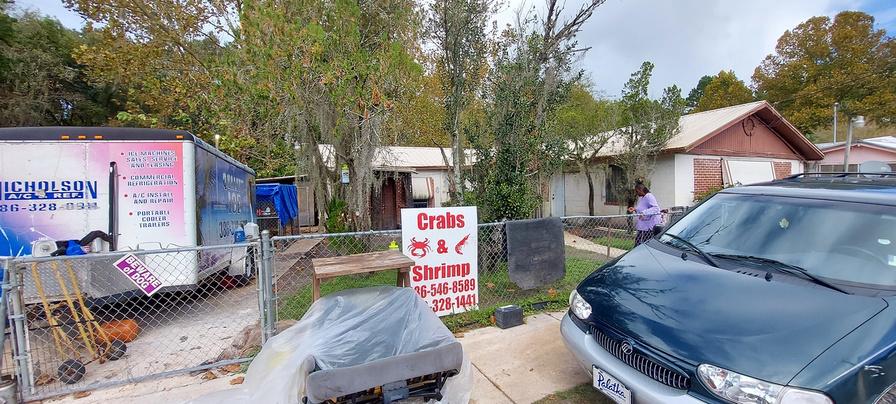

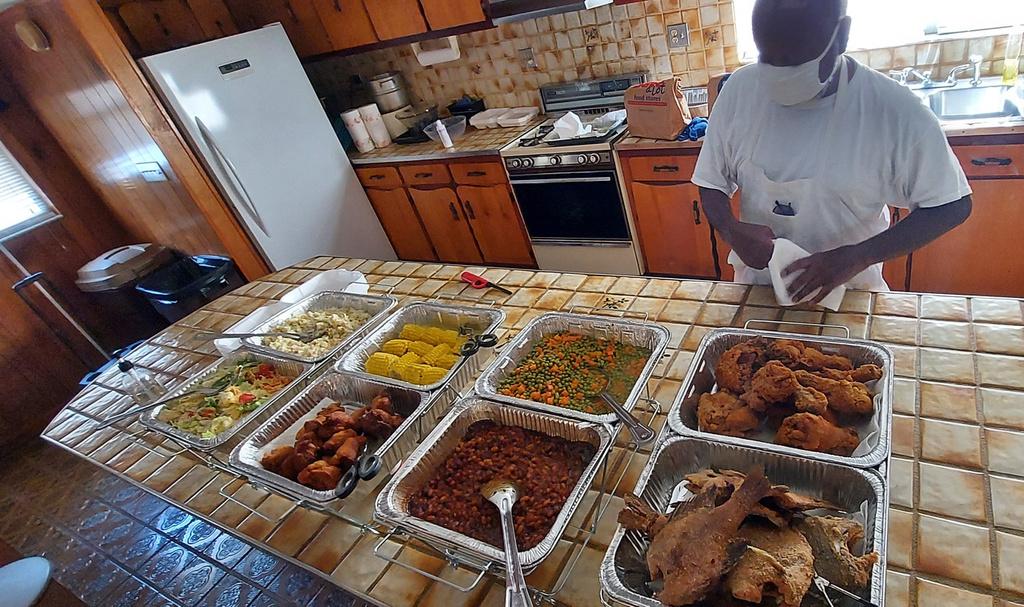

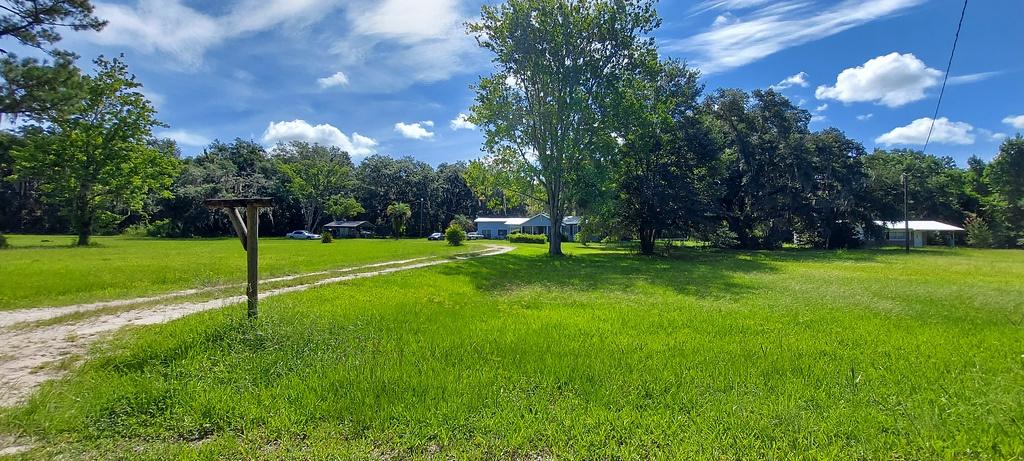
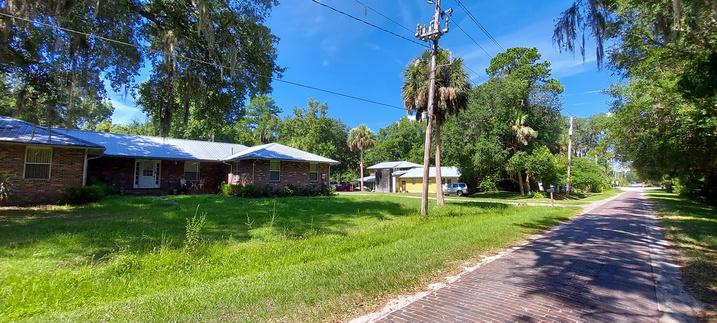


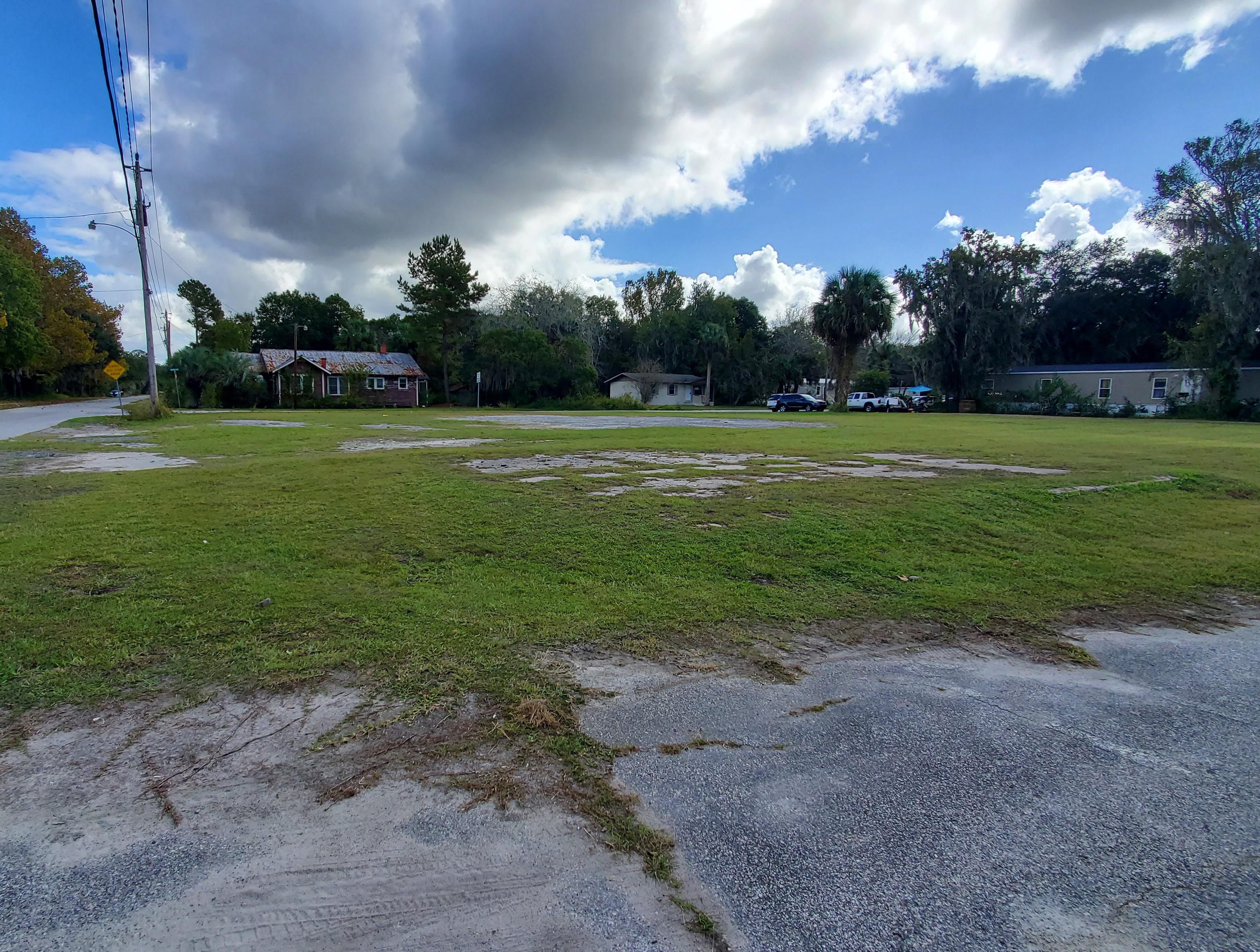
East Palatka has multiple opportunity areas to implement space activation. Space activation takes underutilized areas in a place; such as vacant lots, right of ways, trails, parks etc. to enhance them with temporary to permanent installations that create a sense of community and commerce. This can range from as temporary as sidewalk art and pop-up markets to something more permanent like community signage and shade structures along trails.
Who has a role in space activation?
Individuals, the community, non-profits, local governments, and really anyone!
This tool identifies areas in East Palatka that are ripe for space activation and potential ideas for activation of the site.
SPACE ACTIVIATION REVIEW AREA
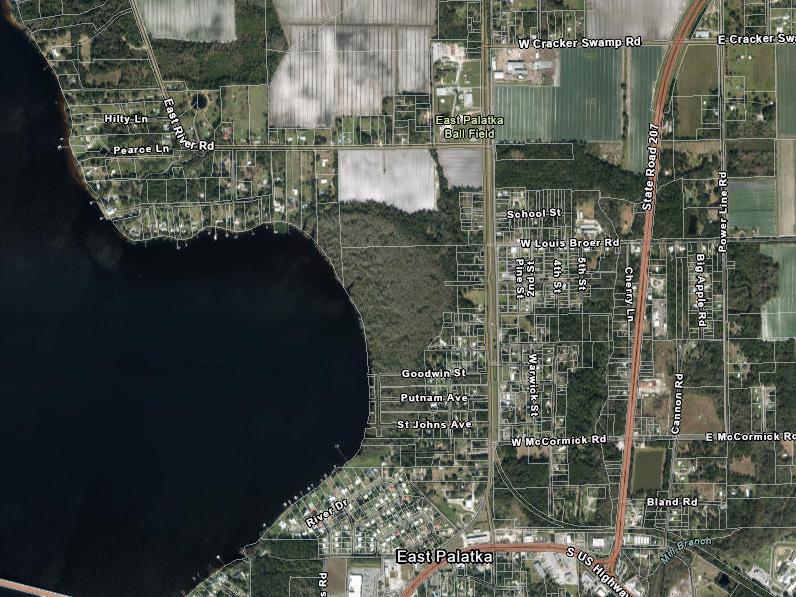

Art and Signage can be used to tell a story or direct people to places in your community. This type of activation can be used to create a reason for people to slow down and learn about East Palatka.


 GOOGLE STREET VIEW
GOOGLE STREET VIEW

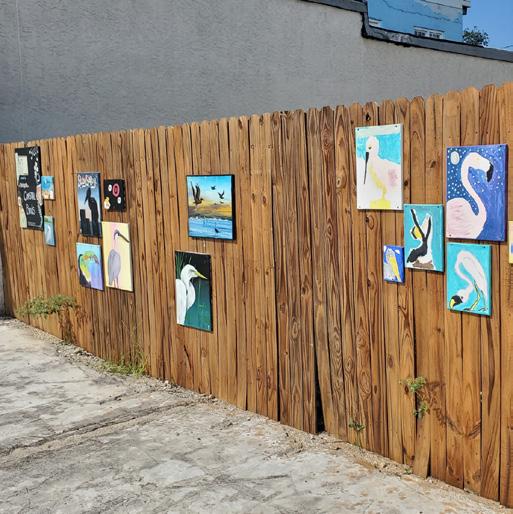





 Street Mural
Fence Mounted Art
Installation Art/ Mural
Community Mural
Bandit Sign
DIY Pole Signs
Sandwich Board
Street Mural
Fence Mounted Art
Installation Art/ Mural
Community Mural
Bandit Sign
DIY Pole Signs
Sandwich Board
For this concept, use sidewalk chalk or tempera paint to add color and messages to pavement throughout the community. (See Image examples below and an East Palatka Idea on the next page)
What is needed?
Materials:
• People!
• Sidewalk Chalk
• Spray Sidewalk Chalk
• Tempera Paint
• Stencils (optional)
• Creativity
Location:
• Along Bike Trails
• On Sidewalks
• Your Driveway
• Etc.

To Note:
• BE SAFE!
• Use Positive Messages and Art, this is an expression of the community.

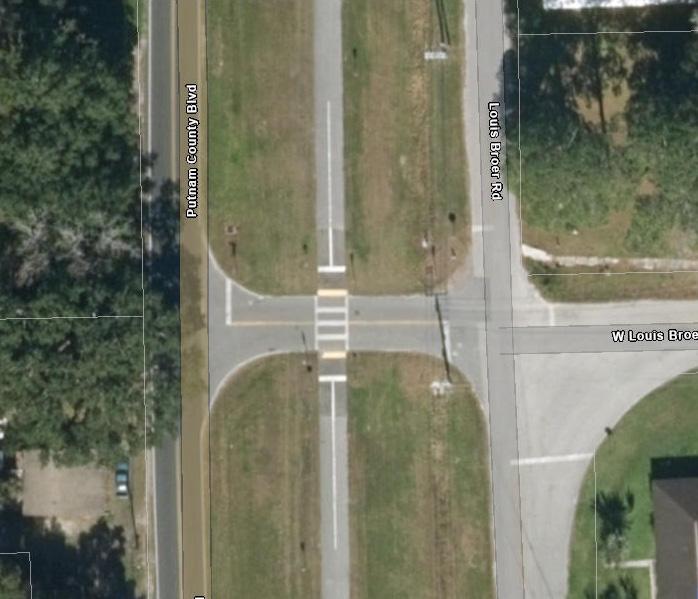
For this concept, use temporary or permanent signage in front of buildings to tell the history of the structure or site. (See Image example below)
What is needed?
Materials:
• People!
• History
• Signage (can be any type)
• Creativity
Location:
• In front of Houses
• Businesses
• Vacant Lots
• Etc.
To Note:
• BE SAFE!
• Get creative with the type of signage. These can by very simple or detailed but keep them consistent!

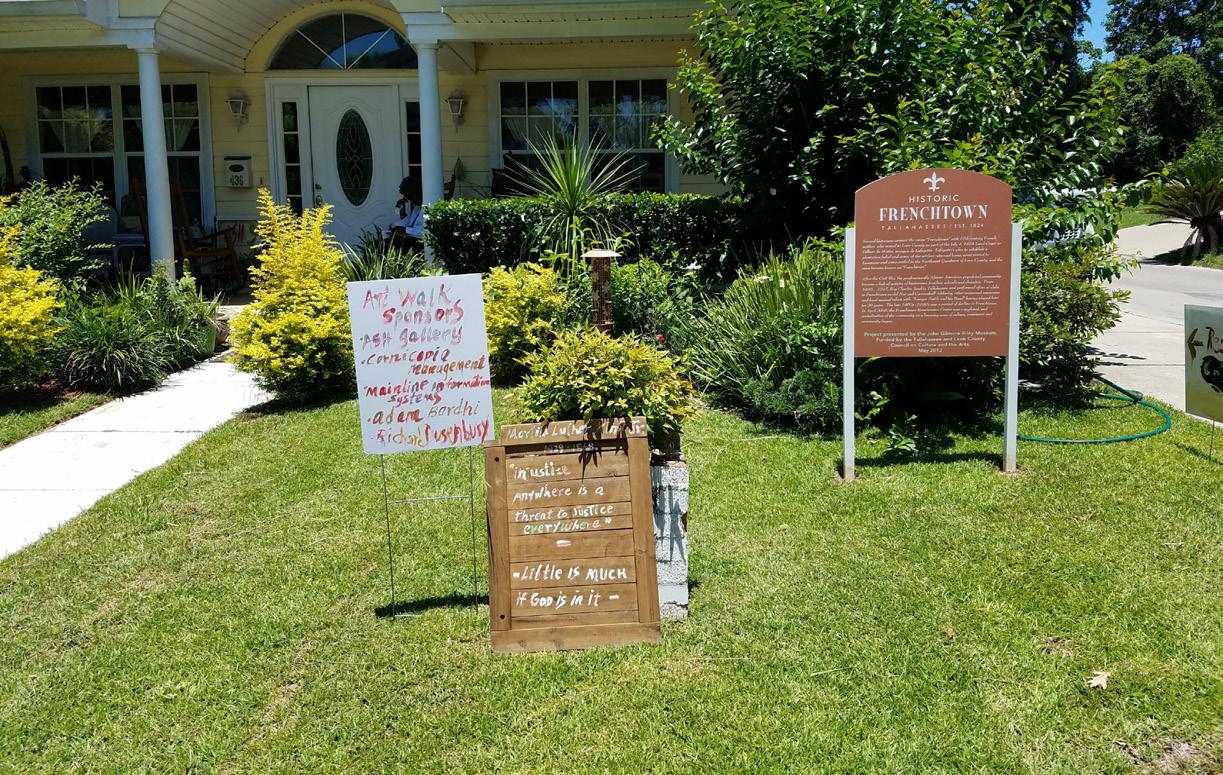

Pop-Ups are a great way to provide commerce in an area that may be lacking commercial uses. This can be in the form of Food Trucks, a peanut person, arts and craft sales, markets, etc. This type of activation not only provides a service for the people currently living in the community but also draws people in that might be passing thru East Palatka.
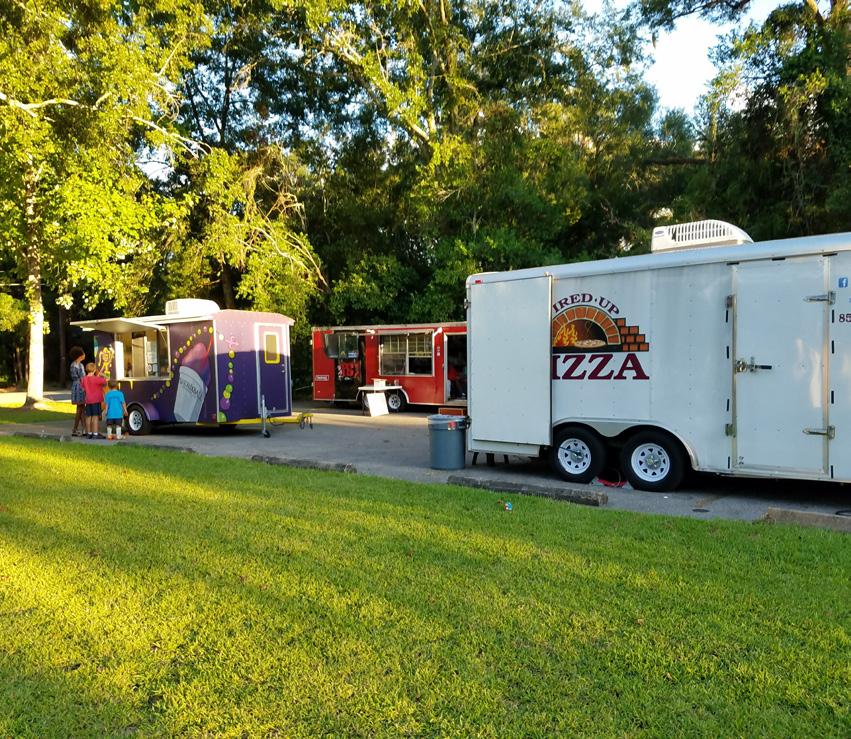


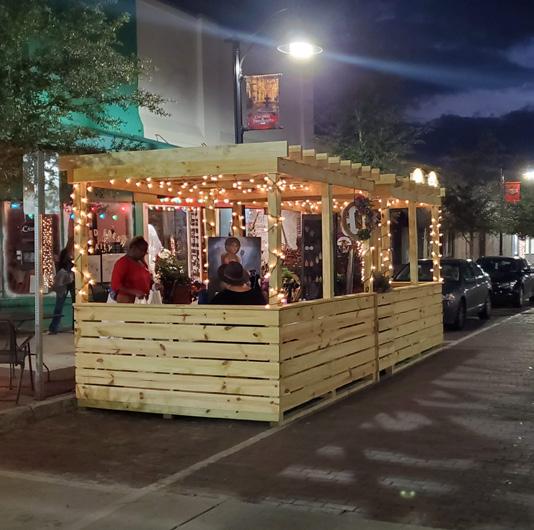



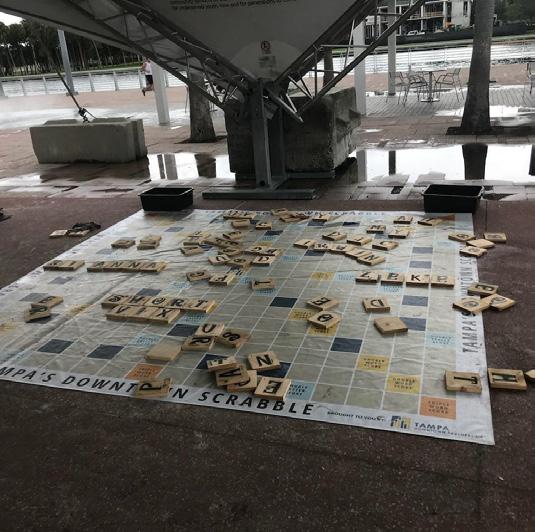

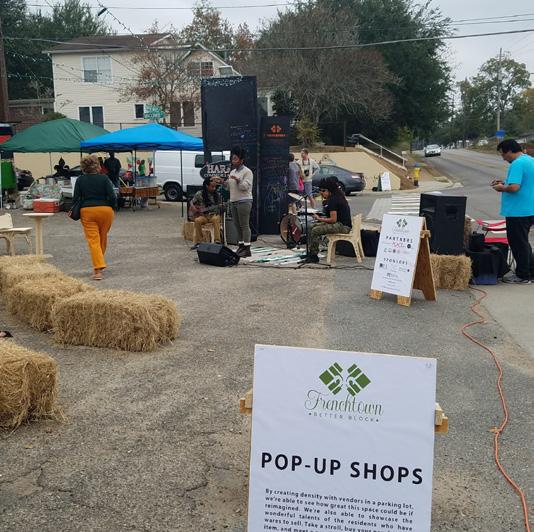

For this concept, Identify vendors that would want to be part of a market and set a series of dates that the market will be held. Vendors may include artist, produce, food, crafts, etc.(See Image examples below)
What is needed?
Materials:
• People!
• Pop-Up Tents
• Vendors
• Music (optional)
• Lots of energy!
Location:
• East Palatka Ball Field
• Beside the Bike Trails
• Etc.
To Note:
• BE SAFE!
• Be sure to tell people about the market and have flyers!
• Ask churches to share info
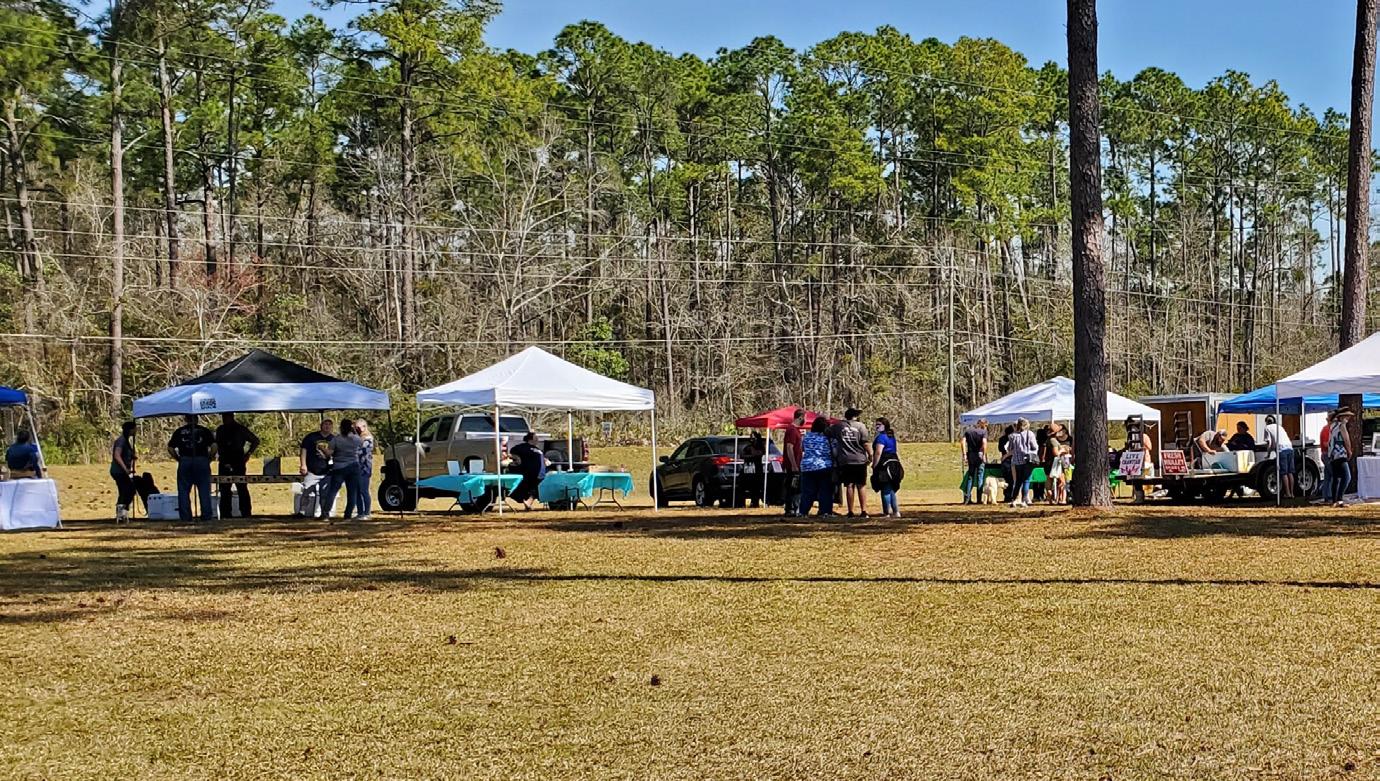



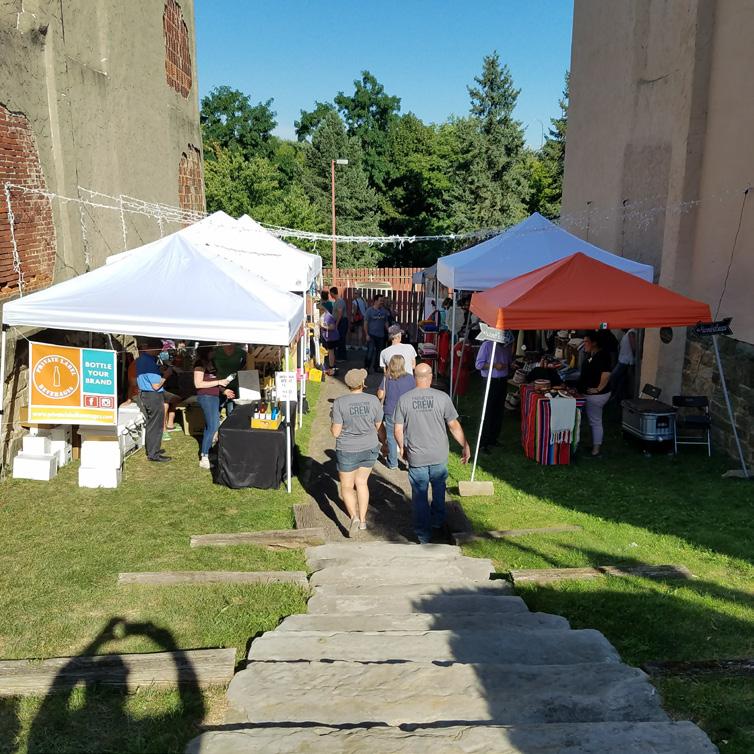

Create a Pop-up Market on the Basketball Courts with Tents
For this concept, find vendors that would want set up more regularly than for a market and have set locations of where they would be in the community. This would be folks like the BBQ person, peanut person, seafood person, car washer, someone selling water along the bike trail, etc. (See Image example below)
• Place to set up What is needed?
Materials:
• People!
• Vendors
Location:
• Identify locations visible to people passing through the community. (ie. Along Trail, on Louis Broer)
To Note:
• BE SAFE!
• Ask property owners for permission to set up
• Ask churches to uses parking lots

Vacant lots can be used as places for events and gathering spaces for communities. This is great for birthday parties, family reunions, Heritage event, baby showers, football game viewing, playing sports, etc. To make this happen, identify the vacant lots and contact the owners for permission! (See Image example below)
What is needed?
Materials:
• People!
• Creativity
• An event
• Seating
• Shade
Location:
• Identify vacant lots that are accessible to the community.
To Note:
• BE SAFE!
• Ask property owners for permission to set up
• Ask churches to uses parking lots
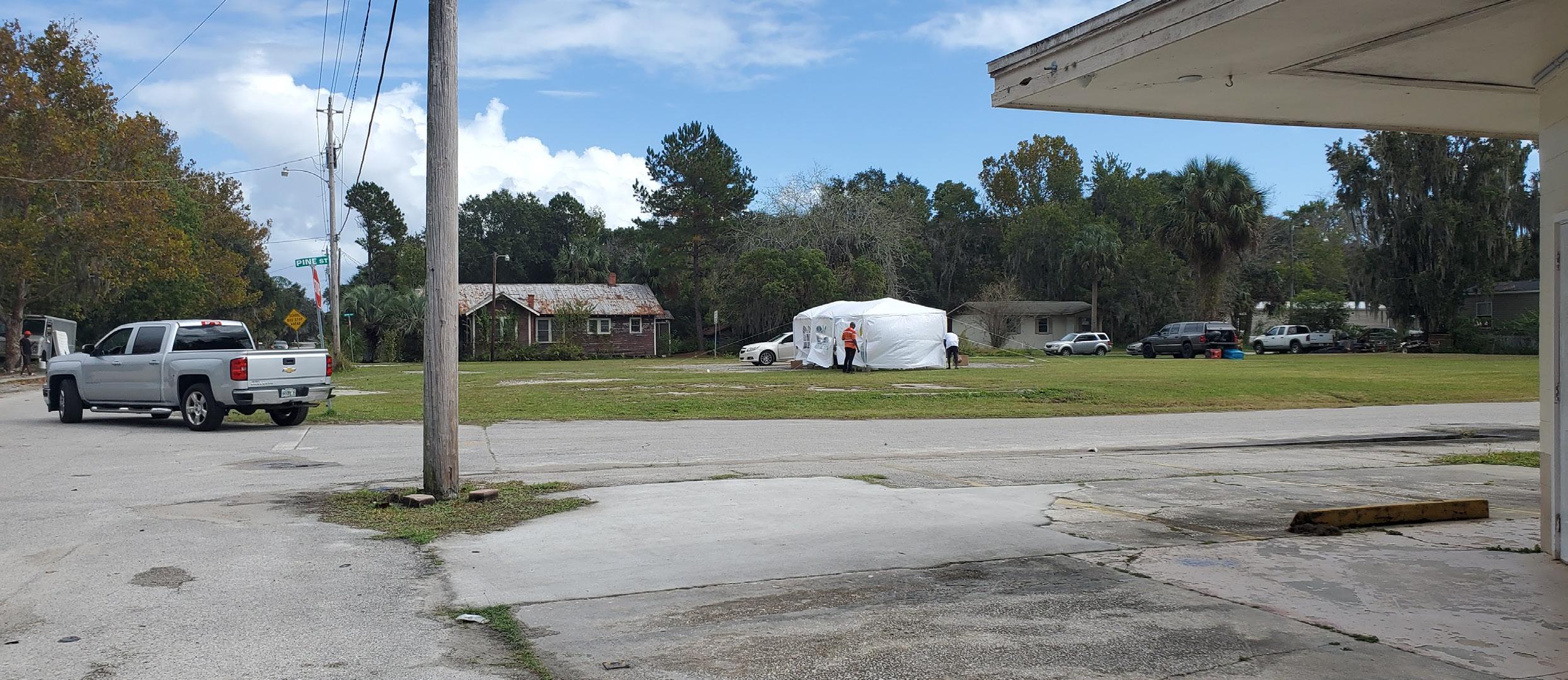
East Palatka has multiple amenities throughout the community that are currently used by the residents and those passing through. This includes the Palatka to St. Augustine Trail. Providing enhancements to these amenities would add to the beautification, comfort, and place of East Palatka. The following enhancements would take coordination from both State and Local Jurisdictions


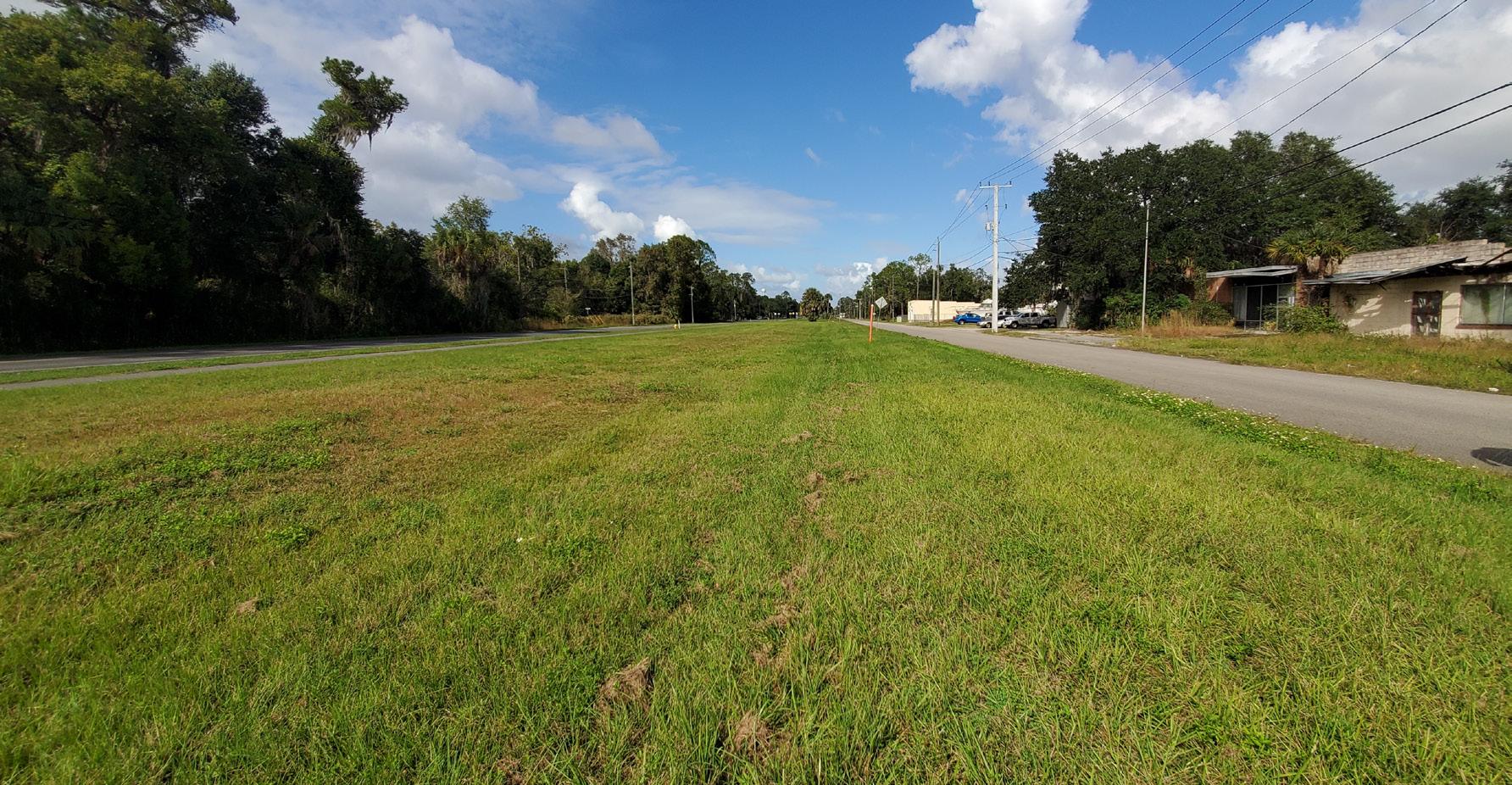


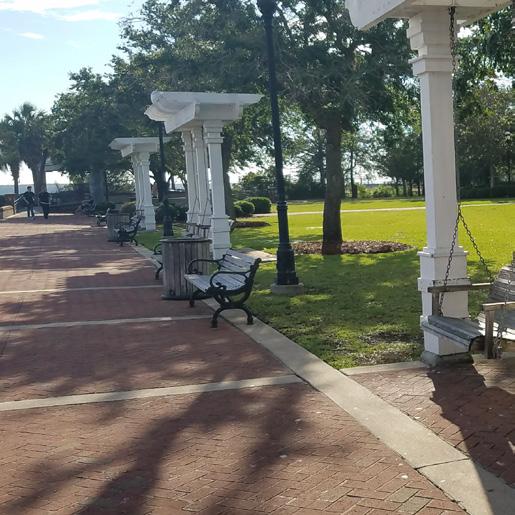

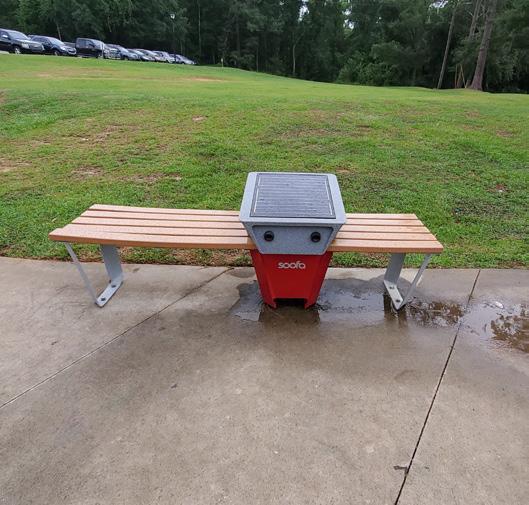



The Palatka to St. Augustine Trail is a very poplar ride for cyclist and other users. One of the trail heads is located at the end of Louis Broer Rd., and the road was even closed to vehicle traffic. A covered refuge for trail users to break from the sun or weather would be a great addition. (See Image example below)
What is needed?
Partners:
• People! (Users of Trail)
• Putnam County
• State of Florida (Trails)
Location:
• End of Louis Broer Rd. where it formerly connected with River Rd.


Amenity:
• Covered Refuge with Seating

The former Volunteer Fire Station, currently owned by Feed the Need Putnam, is a unique building that could provide multiple opportunities for community activities. The large garage doors lend well to a covered market, activities that can span inside to outside, and a general gathering space.
What is needed?
Partners:
• Feed the Need Putnam
• Community
• Putnam County
Location:
• 1508 Louis Broer Rd.
Amenity:
• Market
• Events
• Parking Lot Pop-Ups
• Pop-up Bicycle Shop

The Palatka to St. Augustine Trail was formerly the Florida East Coat Railway. This line was in operation at some capacity up into the 1980s. Identifying the location of the train stop and using that site location for a community amenity has the potential to share the history of the East Palatka Line in a unique way.
What is needed?
Partners:
• People! (Community Members, Users of Trail)
• Putnam County
• State of Florida (Trails)
• Historical groups
Location:
• TBD: however based on old images, it appears to be along the trail between Power and Cynthia St.
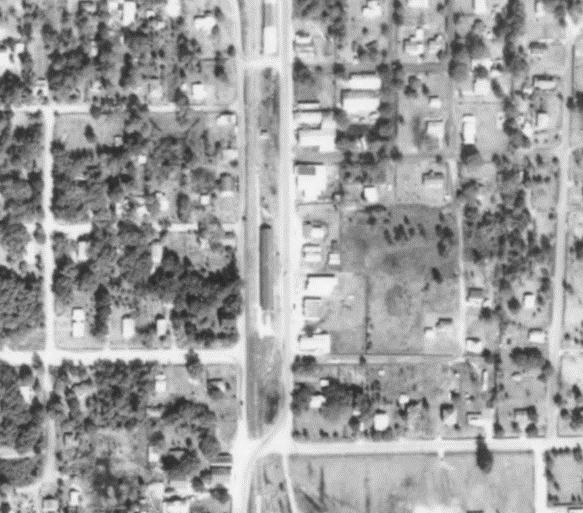
Amenity:
• Train stop replica
• Pavilion in shape of the train stop
• Historical display at the location

The Palatka to St. Augustine Trail is a great location to have pull off areas for cyclist to clean or repair bike issues. These amenities are often compact and do not take up much space. You never know when you might need to put air in your tire and its nice to have a spot you know you can do that!
What is needed?
Partners:
• People! (Users of Trail)
• Putnam County
• State of Florida (Trails)
Location:
• Near or at Trail Head
Amenity:
• Bike Rack
• Bikie Fixing Station w/ pump and tools

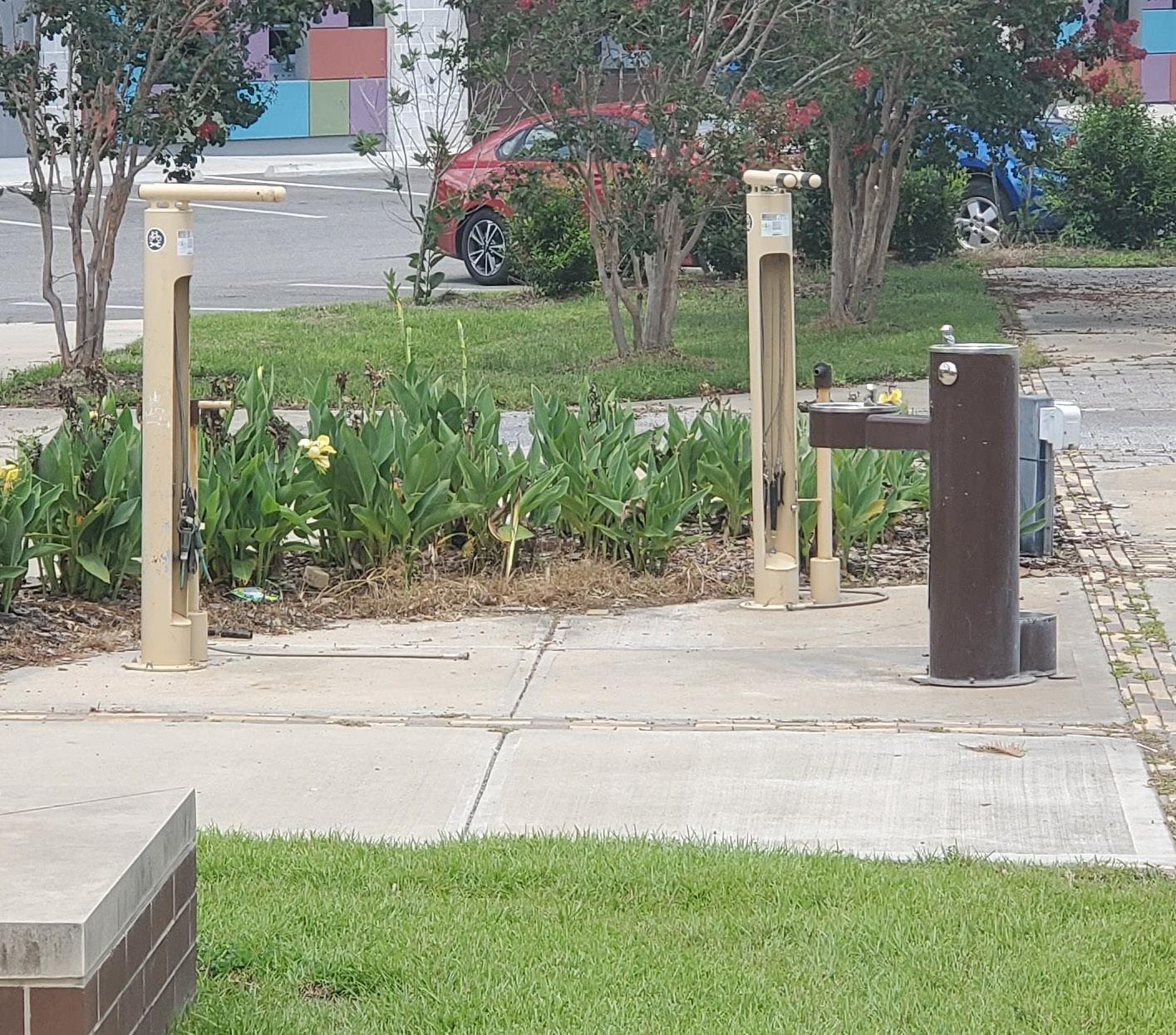

The East Palatka Community has many opportunities for space activation and the immediate next step is to implement an activation project. Below you will see a basic guide to implement a space activation project. Remember this is meant to be fun and bring the community together for a common cause.
1: Identify the Project (ie. East Palatka Heritage Event)
2: Identify by name who wants to be involved
3: Have those involved meet to organize the event (look for ways to incorporate the space activation ideas 1-9 in this guide)
- Date, Time , Location
- Vendors/pop-up vendors
- Music/ entertainment
- What is the event highlighting (Culture, History, Community, All of this!! Etc.)
4: Assign tasks for 3 above to those involved and have a way to report what has been completed
5: Assign day of event tasks to those involved and volunteers to help with set up and other needs that arise
6: ENJOY THE EVENT!! Take photos, post on social, make it fun!
7: Clean up the site
8: Plan the next Space Activation Project!



University of Florida, Department of Urban and Regional Planning
Prepared by URP6931 Community Engagement
Jacob Alderman, Madison Eichhorn, Arielle Hernandez, Erik Kramer, Hillary Laskey, Kestner Linares, Nicolette Lyons, Mofoluso Murnane, Hannah Van Curen, and Dr. Kathryn Frank



A special thank you to our project partners for their support throughout this process.
East Palatka is a rural farming community located in Putnam County, Florida. Situated on the east side of the St. Johns River, East Palatka is home to a tight-knit community characterized by its small residential dwellings, historic churches, and agricultural atmosphere (Davis, 2023). East Palatka has a long-standing African American population tied to its region’s agricultural roots producing cabbage and potatoes. There are also strong cultural ties to the Gullah Geechee heritage. The total population in East Palatka according to 2021 census data was 1,375 people, with 38% African American, 53% white, 6% Hispanic, and 3% other races/ethnicities.
East Palatka was selected by the Florida Chapter of the American Planning Association (APA Florida) to serve as a Community Planning Assistance Team (CPAT) project. The goal of CPAT is to help embolden community voices and create community-led changes and solutions that are equitable for members (Community Planning Collaborative, 2023). CPAT offers several services including preserving history and culture, community development, recognizing historic markers and trails, community engagement and grant writing (Community Planning Collaborative, 2023). East Palatka was selected after inquiring about revitalization and preservation assistance.
The East Palatka CPAT is led by Mr. Ennis Davis, AICP, and Ms. Adrienne Burke, AICP, Esq., (principals of Community Planning Collaborative), and Ms. Sharon Austin, an East Palatka resident and leader of Hand-N-Hand Community Services Foundation, Inc. Assisting the CPAT team was UF Historic Preservation Program’s Dr. Cleary Larking and staff, and Patti Shea, Communications Manager at APA Florida.
During the Spring 2023 semester, nine students from the University of Florida’s Community Engagement course developed several community engagement recommendations for East Palatka. Deliverables for this project included developing an informative flyer for the CPAT community engagement event on April 8, 2023, attending the event, and developing proposed community engagement processes for future events centered around planning for the East Palatka Community (or County) Park (aka East Palatka Park) and its connection to the Palatka to St. Augustine State Trail
The project began on March 6, 2023, when Mr. Davis and Ms. Burke of the CPAT team visited the Community Engagement class. This initial meeting provided the project group with background information on the CPAT as well as the East Palatka community. It was also the first mention of the community event held at Morning Star Baptist Church on April 8, 2023. With input from Dr. Larkin, the focus of the event was explained to be on historic preservation, including oral histories and initiation of master site file forms to record historic buildings and sites; and the event would include open house stations, including one concerning the East Palatka Park.
After the initial March 6th meeting, our group began drafting three flyers promoting the April 8th community event (see Appendix). Throughout the process of designing and drafting the flyers, several group members reviewed the flyers for clarity, content, and aesthetics. When we were satisfied with the three drafts, they were shared for review with the CPAT team, including Ms. Austin. The CPAT team selected one of the drafts which we then revised again based on their comments. Once the design phase was completed, 90 flyers were printed. Originally, we had planned to print 250 flyers based on the
projected needs of the community. However, due to budget limitations, we decided on 90. Two group members then hand-delivered flyers to Sharon and posted flyers at several local businesses on March 28.
Four group members attended the April 8th event at Morning Star Baptist Church. The group was split into shifts so there would be students at the event the whole time. These members stayed at the church to interact with community members, observe the work of CPAT, and assist with anything needed (Figures 1, 2, & 3).
Three other group members traveled to the nearby East Palatka Park to observe the current state, conduct a simple site analysis, and brainstorm ideas for future engagement surrounding park improvements (Figures 4, 5, & 6) East Palatka Park is an open area lot off Putnam County Boulevard in the East Palatka community with an opportunity for new park development and revitalization of existing parks.
Both groups were responsible for taking notes and photos that could assist in the writing of this report and our recommendations for future engagement

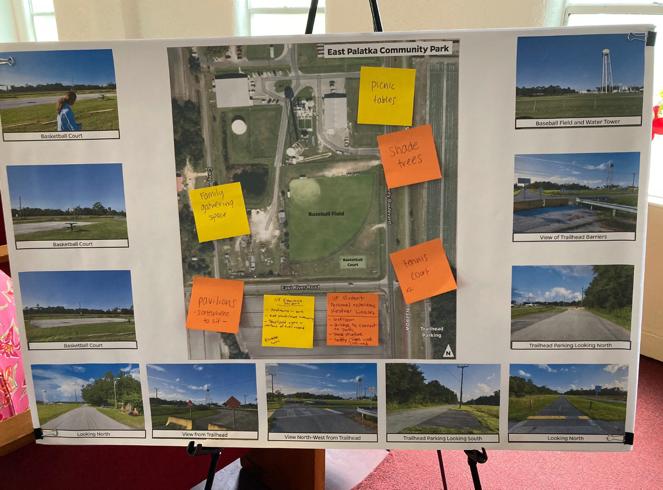




Finally, our group used course content and the images, notes, interactions, and site analysis from the April 8th event to compile the recommendations we have created in this document. In addition to this report, three group members presented a condensed version of this report to the CPAT team as well as our other classmates. The feedback received during the presentation is included and can be found in the conclusion of this report.
We recommend six community engagement approaches for future community engagement focused on the East Palatka Park: Survey, Visualization, Youth Engagement, Community Meal Events, Church Gatherings, and Establish a Community Group. The approaches may also be suitable for other planning topics of the East Palatka CPAT.
For the engagement recommendations below, the three flyer options we created the April 8th event may be useful (Appendix). The graphics of the orange flyer is especially suitable for an event focused on park planning, and it includes a Spanish version for Hispanic residents.
The first suggested engagement mechanism is to conduct survey research to understand better the community’s feelings, perceptions, and recreational use of the East Palatka Park and adjacent trail. There are several approaches to gathering attitudes. Developing a survey with questions about how often the participants use the facilities, what activities they use it for, and any general perceptions or comments. The survey could also be used as a precursor to other community engagement mechanisms, helping to inform goals and participation in a subsequent event.
1. Below are a few sample questions for the survey:
a. How often do you visit East Palatka Park or use the trail?
b. Select what activities you do here:
i. Basketball
ii. Walking or running (without pets)
iii. Walking or running (with pets)
iv. Bicycling
v. Picnics, barbecues, or other meal-sharing activities
vi. Meet-ups with friends, families, or the community
vii. Other (please specify)
c. What is the average time you spend using each facility when you visit?
d. What facilities would you like to see at the East Palatka Park? (Ex: Tables, Shade, Water Fountains, etc.)
The survey can be disseminated online with the help of Hand-N-Hand's Facebook page, or it could be emailed to community members and converted into a QR code to put on the flyer. Sharing the survey in person is another viable option, perhaps at church gatherings or other community events. Alternatively, volunteers can canvas East Palatka to survey participants door-to-door or at key venues. No matter the chosen method of delivery, the goal of the survey should be to learn how the park can better serve the needs of the East Palatka community. The results should be analyzed and used to inform supplementary community engagements like the options discussed below.
Visual information is akin to a common language that people of different backgrounds and experiences can understand; therefore, visualization could be an effective tool for encouraging participation in redesigning and renovating the East Palatka Park to fit the needs and priorities of East Palatka residents. There are several ways Visualization could be implemented as a technique for community engagement in several ways including GIS, electronic 3-D modeling, photo-editing software (such as Adobe Photoshop), electronically or physically created art, tangible photos, and physical 3-D modeling using shape blocks, props, and figurines. The desired result is a process through which stakeholders co-create and see a realistic representation of how their park could look or function.
We believe both physical and electronic art, photo-editing, and physical 3-D modeling are viable options based on our observations of residents and available venues. We noted that residents who attended the April 8th event were keen on orally discussing their individual experiences and their town’s history. This style of discussion could lend itself well to electronic or physically created art, so implementing either approach would boil down to available human and material resources and the designated venue. Human resources refer to the artists that CPAT has connections to in their social networks in the American Planning Association, the University of Florida (or other universities), local jurisdictions, and the East Palatka community itself. A limited pool of artists would limit visualization opportunities to those who are willing to assist with the project and their skills (e.g., photoshopping, painting). Material resources refer to the available budget to hire artists, rent or pay for any supplies (projector, screen, paint, banner paper, shaded tents, etc.), and transport people or supplies. CPAT could partner with the University of Florida or other higher-learning institutes to secure an artist who is willing to offer their services probono. One option might be more viable depending on CPAT’s budget and pool of resources.
The choice of venue matters as well. Electronic art would be easier to create in a church that has internet access and space for necessary equipment; although, physical art would be a viable option if there is enough open space for tables, easels, and other necessary equipment. Physically based visualization techniques would work well at the East Palatka Park site since there is ample space to set up the necessary equipment. Engagement at the park could complement any visualization method because stakeholders can experience the environment first-hand and in-real time; although, the downside would be the unavoidable Floridian heat and humidity. Engagement at the park would also require more material resources to make the experience more comfortable for all participants due to the lack of shade and bathrooms. Water, tents, and access to bathrooms will be necessary.
No matter the avenue – physical or electronic – the goal of visualization is to co-create a vision for the future of East Palatka Park with the stakeholders to fit their needs and priorities. Some suggestions for visualization activities or prompts include the placement and design of murals that contribute to the
cultural and historic preservation of the community, park facilities, amenities, and vegetation. We asked several residents at the April 8th event about the park – several did not immediately recognize what we were talking about. Ms. Austin needed to remind these residents that it was near the water treatment facility, which seemed to be the most recognizable feature, instead of any of the few amenities at the park. Discussions with the residents suggested there was no commonly known name for the park – Ms. Austin called it the “barren park” due to its lack of amenities. It would be beneficial to ascertain the communities’ opinions and input on the park through visualization sessions and supplementary engagement opportunities like surveys or social media feedback. Based on the resident input we gathered and site analysis from our team, we suggest that participatory placemaking is a relevant goal for this type of engagement in which the outputs are clear ideas of what the residents want the space to look like and be used for.
Below is a bulleted outline of a visualization activity using an artist.
Preparation:
• Collect residents’ ideas, desires, needs, priorities, and uses related to the park before planning the visualization activity. This can be done through surveys, focus groups, or semi-structured interviews.
• Take inventory of available resources and results from your chosen data collection technique, then determine the most appropriate art medium and venue.
• Design a general guideline for discussion points based on the main themes from collected data. For example, some themes we heard at the April 8th event were the need for bathrooms and safer sidewalk access to the parks. Be prepared to embrace deviations in discussion points based on the stakeholder’s desires during the activity.
• Compiles images of East Palatka Park in an easily navigable format for the artist to access during the activity.
Activity:
• Introduce the purpose of the activity
• Discuss the main themes of previous engagement regarding the park
• Open the floor for people to share their views and ideas. This could happen similarly to the April 8th event, by inviting them to the front of the venue to speak
• Consider writing the main points discussed at the event for the artist’s reference
• The artist will capture the essence of the stakeholders’ ideas through their preferred medium and be ready to share their products for feedback with the stakeholders
Photo-editing techniques and physical 3-D modeling could also be utilized, assuming there are opportunities for multiple workshops dedicated to park planning and design. Photo-editing or physical 3D modeling allows stakeholders to further refine ideas and visuals created through physical or electronic art sessions into more realistic, tangible creations in an interactive manner. Again, the viability of options depends on the resources and venues available; however, they would be better utilized as follow-up activities because they require considerable time for preparation and an existing sense of direction (which the art sessions are intended to provide). These techniques would be used after initial information and ideas are gathered from physical and electronic artist sessions.
Photo editing would require an artist with a specific skill set that allows them to add and remove details to park images promptly as desired by stakeholders. It would also be easier to accommodate this technique
at a church venue. The artist or CPAT would need to compile Photoshop material ahead of time, such as shapes and structures, to make the activity run smoothly. This activity is valuable for fine-tuning the design drafts to reach the final product.
Physical 3-D modeling is less human-resource intensive, as stakeholders could interact with a map and manipulatives (wooden blocks, figurines, etc.) and make changes as desired; however, it would take more material resources and funding to create a realistic activity. Physical 3-D modeling has the potential to engage the youth of East Palatka. For example, young children and teenagers could recreate the park how they want by using building blocks, such as Legos. The park would be an appropriate venue for this option since stakeholders can observe their surroundings in real-time; although, a church venue would be viable if supplementary park images can be displayed on a projector, or each participant is given physical copies.
Two things are likely to get young people engaged: food and sports, or perhaps a combination of both. Conducting youth engagement can serve as a way of expressing pride and foster a way for students to stay rooted in what is going on in their community. It can also provide young people in the East Palatka community to contribute their ideas and suggestions as to how to improve their community.
Palatka High School is a public high school located in Palatka, Florida, and serves the Palatka and East Palatka areas. Robert H. Jenkins Junior Middle is a public middle school located in Palatka, FL. These schools are a great place to combine community engagement in East Palatka with youth engagement and are an option for community engagement geared towards the youth particularly youth in the middle to high school age range.
Name of Event: East Palatka BBQ & Balling Preview
Suggestion for name of League: East Palatka “Ballers”
Age target: middle school & high school students
Objective:
• Familiarize the location of the park with the students
• Getting more students excited to use the location gives credence to the need for the city to develop the park further
• Bring visibility to the park from the local high school, middle school, and local community
Materials/Giveaways: T-shirts, flyers, food
Action Time: 2 – 4 Hours of play and interaction time throughout 6 – 8 games in the future
Frequency: Inaugural event followed by weekly games for about 8 weeks
Additional Sponsor: Local restaurant and parents
Description of Event:
The inaugural event is set up as a pre-engagement activity to get students and the local community excited and informed about a local basketball league.
Flyers are created to share specific information about the event, but it is important to use social media to spread the word. Specific reference should be made on the flyers to encourage attendees to bring personal chairs since there is no available seating in the park.
Local restaurants are invited to sponsor food at the preview event. Sign-up sheets at the preview event can be used to get parents or community members to sign up to bring weekly snacks and drinks for the remaining season.
The preview event would include a sign-up sheet for interested participants, the options for sign-up would include players, coaches, and snack providers. A link to the sign-up sheet would also be provided on social media.
Basketball leagues are seasonal and selecting a consecutive basketball season (typically 6 – 8 consecutive weeks), is critical to maintaining regular contact and engagement with participating youth from the local middle and high school.
A basketball league requires 5 players (and maybe 2 alternates) so building two teams of 10 – 14 students from the local schools is feasible, scalable, and gives room for the program to grow.
The league can be led by role models who live in the community and are willing to impact and participate in youth mentoring.
Another option is to get high school varsity coaches involved and give everyone – coaches, athletes, and parents – the opportunity to participate and build a solid, positive relationship.
For parents, having their children participate in a community basketball league provides a sense of community and connection and gives the kids a place to go.
For the kids, having a place to go to in their neighborhood gives them a chance to be heard and allows them the opportunity to share new ideas in ways to develop their community
Action and feedback required:
• At the preview event, ask the kids if there are other play areas they use in the vicinity
• At each weekly game, students spend some time participating in a conceptual activity to redesign the park and accessibility to the park
• Parents and community members share feedback on desired outcomes and impact
• A sign-up sheet to participate in ongoing engagement
It has long been recognized that food is a powerful tool for bringing people together. Sharing a meal provides the opportunity for people to congregate and converse, encouraging collaboration and relationship building. Food can be used as an incentive to engage important population groups, like the youth, and as a catalyst for increasing social capital and engagement within a community. Food can also be used as an icebreaker to find commonalities, as a builder of relationships and community, and as a tool for empowerment.
Hosting community meal events can also be a way to engage local restaurants and businesses, helping the local economy and bringing awareness of local services to community members. Furthermore, community meals can be facilitated through collaboration between vested stakeholders and relevant partners. The community of East Palatka could work with institutions, like the University of Florida, planning organizations, such as CPAT, and community organizations like Hand-N-Hand, to facilitate a
community meal that brings together vested members of East Palatka to discuss potential plans for the East Palatka Park.
The April 8th event was held at Morning Star Baptist Church. The event successfully brought together members of the African American community to address concerns, educate community members, and share resources on the efforts to preserve historic landmarks in East Palatka. Because th e event had good participation and facilitated meaningful discussion, future churches should be used as meeting sites. Churches are historically hubs for gathering and information sharing, so tapping into that will be effective. Partnering with fellow churches in East Palatka gives more opportunities to reach a wider audience.
Community groups are grassroots organizations that work for public benefit and are maintained by committed volunteers. Community groups can bring about social change by improving community decision-making, addressing public health and safety concerns, and fostering economic growth within a community (Street Civics, n.d.). Aside from encouraging civic engagement, community groups can pass on the act of advocacy and organizing to future generations, promoting long-lasting change. Benefits resulting from the establishment of a community group include empowerment, connection, and support, aside from the social, political, and economic change that often results.
Community groups typically have several foundational elements in common including a shared purpose, transparency, clearly defined values, accountability, diverse participation, strong leadership, and objective governance (Harvard Business Review, 2020)
We are aware that the six proposed recommendations outlined in this report are robust and require organization and funds. To alleviate some of the burdens from one individual or group, we recommend including community champions that know East Palatka’s needs and its residents. For example, creating “Friends of East Palatka Park” would formalize the group of residents and help bring awareness to others. CPAT, local groups like Hand-N-Hand, and government agencies like the Putnam County Parks and Recreation Department could then work directly with “Friends of East Palatka Park” to achieve their goals.
An example of how to establish a community group that fosters community engagement is Strategic Community Partners’ “Recipe for Community Engagement”. Strategic Community Partners, a national firm working towards equity with and for communities, gathers community members through their “Recipe for Community Engagement” series, which is intended to foster community engagement that is organic and unapologetic (Strategic Community Partners, 2022). According to Strategic Community Partners (n.d.), engaging the community and establishing the groundwork for collaboration is facilitated by the following steps:
a. Combine your community with an understanding of it and a desire to work with them
b. Fold in research from your community to understand what they need and want
c. Incorporate feedback from your community to determine the next steps
d. Whisk in communication to ensure everyone is informed
e. Cook your connections until they’re meaningful
f. Incorporate a budget to appropriately cover the needs of the community
g. Bake until the project is ready to be shared with your community
h. Serve and enjoy
Creating a community group within East Palatka could be another avenue for implementing community activities. In creating a community group, vested residents could organize around similar goals and interests, which would have the potential to impact the immediate and future community of East Palatka. If a community group were to be established in East Palatka, it could advocate for improvements to East Palatka Park, develop and facilitate engagement events, and act as a central agency for the community to rely on for the resolution of targeted issues.
We presented the above project findings and recommendations to Dr. Cleary Larkin, Mr. Ennis Davis, and Ms. Adrienne Burke on April 24, 2023. They provided meaningful feedback to be reviewed and incorporated into the future engagement plan. Below are the noted edits and recommendations:
• Target teenagers and children for survey responses.
• Increase youth turnout at future engagement events held at the park. Youth could be involved in storytelling at the park.
• Brainstorm how to connect with young adults and where to host events they will attend.
• Go to where and when the community is already gathering.
• Consider hosting a future event at Mt. Olive AME Church because it is along the trail system.
• Investigate the history of the East Palatka Park and the community’s attitudes towards it.
• Expand the planning scope of the East Palatka Park to include the old East Palatka Community Club site, which is now named Jerry Bedenbaugh Park (125 West McCormick Road) and the Palatka to St. Augustine Trail that connects the two parks.
The report provided achievable and inspiring recommendations for future community engagement activities, offers further information and possible opportunities for park design, and reports detailed findings on the process. In return, our team gained knowledge of CPAT operations and their effor ts to foster engagement in communities and gained valuable hands-on community engagement project experience through the opportunity to collaborate with CPAT on the East Palatka project. The Community Engagement project group would like to extend a final thank you to the CPAT team and residents of East Palatka for giving us the opportunity to participate in a community project with meaningful social impact.
Community Planning Collaborative. (2023). Retrieved April 20, 2023, from https://www.planningcollab.com/
Commsgodigitial. (2014). Food in community engagement. Retrieved April 22, 2023 from https://www.commsgodigital.com.au/2014/09/food-community-engagement-food-tool-gods-engage/
Davis. E. (2023) Community Planning Assistance Team. American Planning Association. APA FL Retrieved April 20, 2023, from https://florida.planning.org/community-outreach/community-planningassistance-teams/
DATAUSA. (2020). East Palatka, Florida. Retrieved April 20, 2023, from https://datausa.io/profile/geo/east-palatka-fl
Harvard Business Review. (2020). When community becomes your competitive advantage. Retrieved April 20, 2023, from https://hbr.org/2020/01/when-community-becomes-your-competitive-advantage
Strategic Community Partners. (2022). Our recipe for community engagement. Retrieved April 22, 2023 from https://strategiccommunitypartners.org/news/recipe
Street Civics. (n.d.). The benefits and risks of community organizing. Retrieved April 20, 2023, from https://streetcivics.com/the-benefits-risks-of-community-organizing/

Figure A1: Selected Flyer for April 8th Event
Link to edit flyer:
https://www.canva.com/design/DAFeD6DnpG8/GhTIPMBeQlRv52xEhFUDJA/edit?utm_content=DAFe
D6DnpG8&utm_campaign=designshare&utm_medium=link2&utm_source=sharebutton
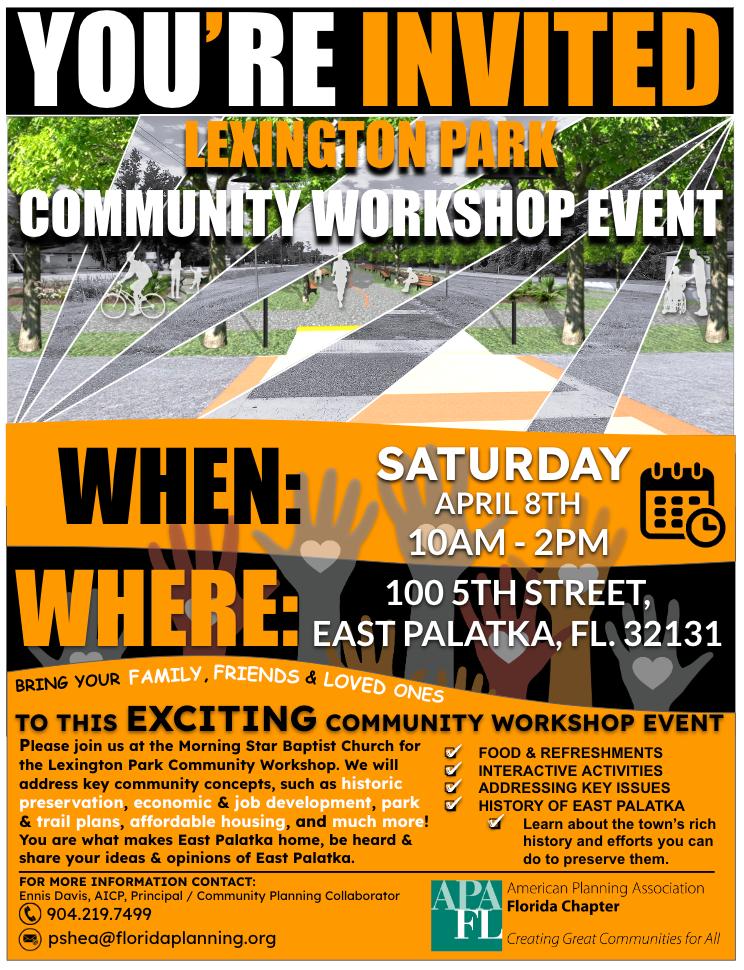
Figure A2: Alternative Flyer for April 8th Event.
Link to edit flyer: https://docs.google.com/presentation/d/1s4jQhmf9EqugoDaiJsyj9TXM3RfvSrPRoshFzMDlDE/edit#slide=id.g23b132d7274_2_49


Grant funding is not available for private historic properties. Grant projects are for public entities such as counties or municipalities, school districts, state colleges or universities, agencies of state government or nonprofits. Grants are competitive application processes that require management and administration. In many cases, grant applications require the applicant to provide a cash or in-kindmatchfortheamountofawardrequested.
The Park Service provides funding for a variety of projects. Grant requirementsandapplicationdeadlinesvary.Grantprogramsinclude African American Civil Rights, History of Equal Rights, UnderrepresentedCommunities,BattlefieldLandAcquisition,Maritime Heritage, Historically Black Colleges and Universities, Disaster Recovery, and Tribal Heritage. National Park Service grant requirementsandapplicationdeadlinesvary. https://www.nps.gov/history/grants.htm
The Library of Congress through the American Folklife Center funds culturalheritageprojectsforfieldresearchanddocumentationwithin diverse communities. Oral history projects and documentary efforts are examples of eligible projects. Projects are archived at the American Folklife Center. https://www.loc.gov/programs/of-thepeople/collect-and-preserve/community-collections-grantapplication/
The National Trust provides funding for a variety of projects. Most grantsareforplanningpreservationprojects.Othergrantsarelimited to specific geographic regions or support nonprofit training. The National Trust funds the African American Cultural Heritage Action Fund and Preserving Black Churches grant programs. National Trust grantrequirementsandapplicationdeadlinesvary.
https://savingplaces.org/grants
Florida DHR provides grant funds from the State legislature and the National Park Service for preservation and protection of the state’s historic and archaeological sites and properties. Two types of grants are available: small matching and special category. Small matching projects include survey, planning, National Register nominations, heritage education, and historical markers. These grants are eligible for awards up to $50,000. Special category grants fund bricks and mortar projects such as preservation, restoration, rehabilitation or reconstruction of historic properties open to the public, archaeological research, museum exhibits for Florida history museums, and acquisition of historic properties or archaeological sites.Thesegrantsareeligibleforawardsupto$500,000.Applications are typically accepted in April/May and project awards are for the following year; for example, applications accepted in 2024 are for projectsthatwouldstartin2025.
https://dos.myflorida.com/historical/grants/
Florida Humanities funds development and presentation of humanities-based cultural resources and public programs.Grants includefundingforFloridaHumanities’speakers,publicmedia,filmor digital projects, and community projects. Florida Humanities grant requirementsandapplicationdeadlinesvary. https://floridahumanities.org/funding-opportunities/
Tax incentives and exemptions are available for eligible private properties.TheFederalHistoricPreservationTaxIncentivesprogramis administered by the National Park Service and the Internal Revenue Service. The primary incentive is a 20% federal tax credit that is available for rehabilitation of historic, income-producing buildings. The first place to start with pursuing these federal tax credits is to contact the Florida Division of Historical Resources. There are consultantswhoassistwithfederaltaxcreditapplications.
The Florida legislature has authorized two types of ad valorem tax exemptions for historic preservation. These exemptions are found in Florida Statutes 196.1961, 196.1997, and 196.1998. Local governments have to adopt these exemptions as local ordinances. One exemption is available for eligible historic properties that are open to the public, and another exemption is available for rehabilitation projects on eligible historic properties. Properties that are eligible get a percentage of their ad valorem taxes exempted. The business exemptionmustberenewedannually.Therehabilitationexemptionis valid for ten years. These tax exemptions would have to be adopted byPutnamCounty.
Another incentive for historic preservation exists that can lead to federal tax deductions. These are called preservation easements. A preservation easement is a legal agreement between a property owner and a third party. These agreements lay out restrictions and conditions on the property that help to preserve the property. The third party is responsible for monitoring and enforcing the terms of the agreement. The tax deductions are determined based on approval by the federal Internal Revenue Service. It is recommended thatifyouareinterestedinpursuingapreservationeasementonyour propertythatyoufirstspeakwithalanduseorrealestateattorney.
Getorganizedwithagroupofinterestedresidents/citizens.
Get to know your local elected officials including members of the Board of CountyCommissionersandPlanningCommission.
ReviewBoardofCountyCommissioneragendasandattendBoardofCounty Commissioner meetings, even if you don’t have an item on the agenda. Having them get to know your community is engaged is important. Different communitymemberscantaketurnsifthatiseasierforeveryone.
If you can’t attend the meetings, call or email Commissioners about agenda itemsyouareinterestedin.
Review Development Review Committee, Planning Commission and Zoning BoardofAdjustmentagendas.Attendthemeetings,emailorcallifthereisan itemofimportancetoyourcommunity.
Engage with the County’s budgeting process. Attend budget meetings and provide comment on community needs. This process usually begins in the springandcontinuesoverthesummer.
Get to know your local County staff in departments like Planning, Parks and PublicWorks.
There is always strength in numbers in terms of meeting turnout, calls, and emails. Don’thesitatetocontinuereachingoutandbeasqueakywheel. ConsiderservingonlocalboardslikethePlanningCommissionorrunningfor electedoffice!
Vote, vote, vote. Local offices don’t get big voter turnout, but have the most directimpactoneverydaylife.
Engagethemediawhereneededtoelevateattentiontoissues.
Gettoknowyourlocalstaterepresentatives.
Email, call and meet with them to let them know about issues important to yourcommunity.
Engage with other advocacy groups like the Florida Trust for Historic Preservation around specific community interests. These groups often host lobbydaysinTallahasseethatthecommunitycouldattendaswell. Voteandgettoknowcandidates.
Gettoknowyourlocalfederalrepresentatives.
Email, call and meet with them to let them know about issues important to yourcommunity.
Voteandgettoknowcandidates.